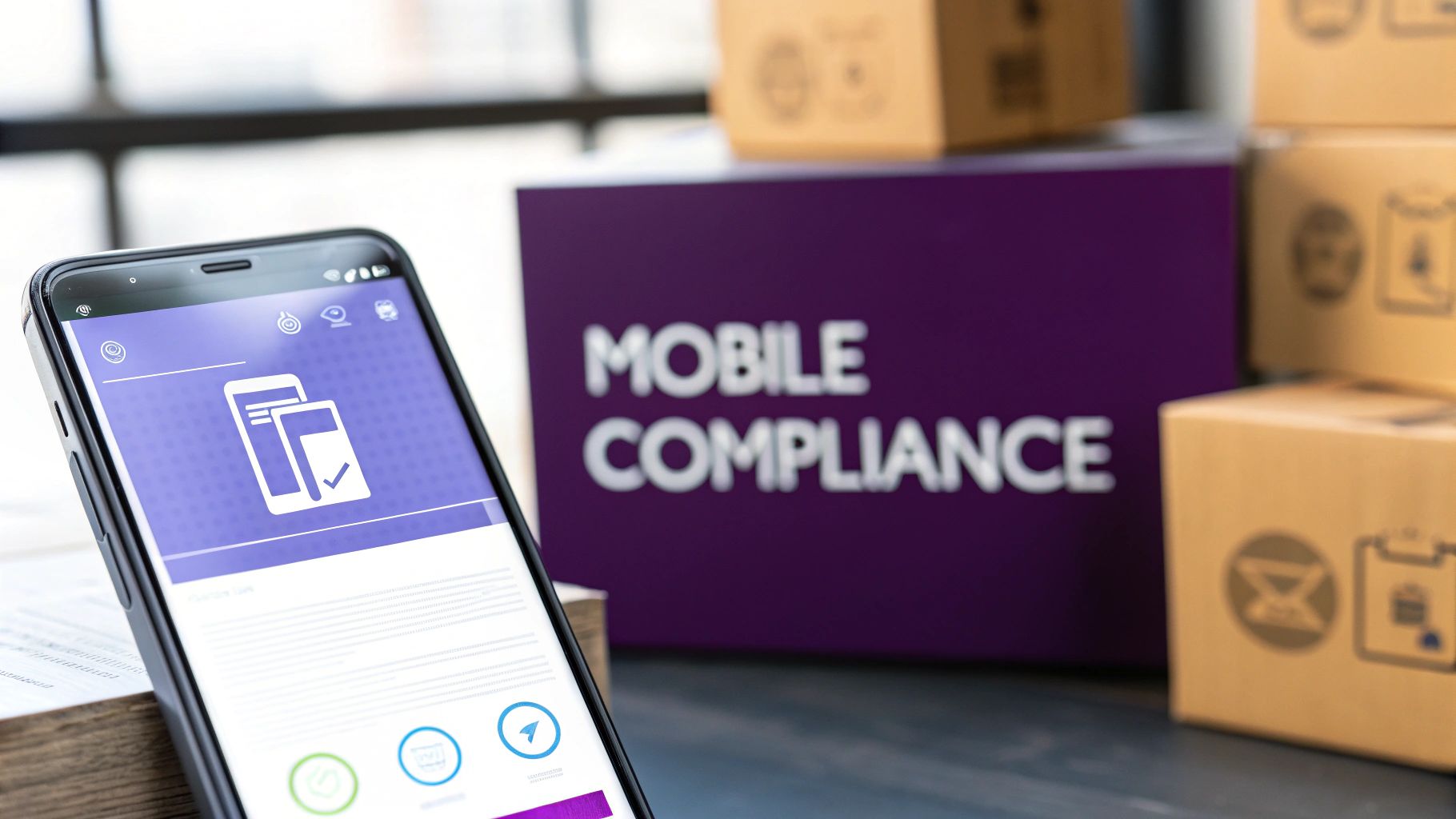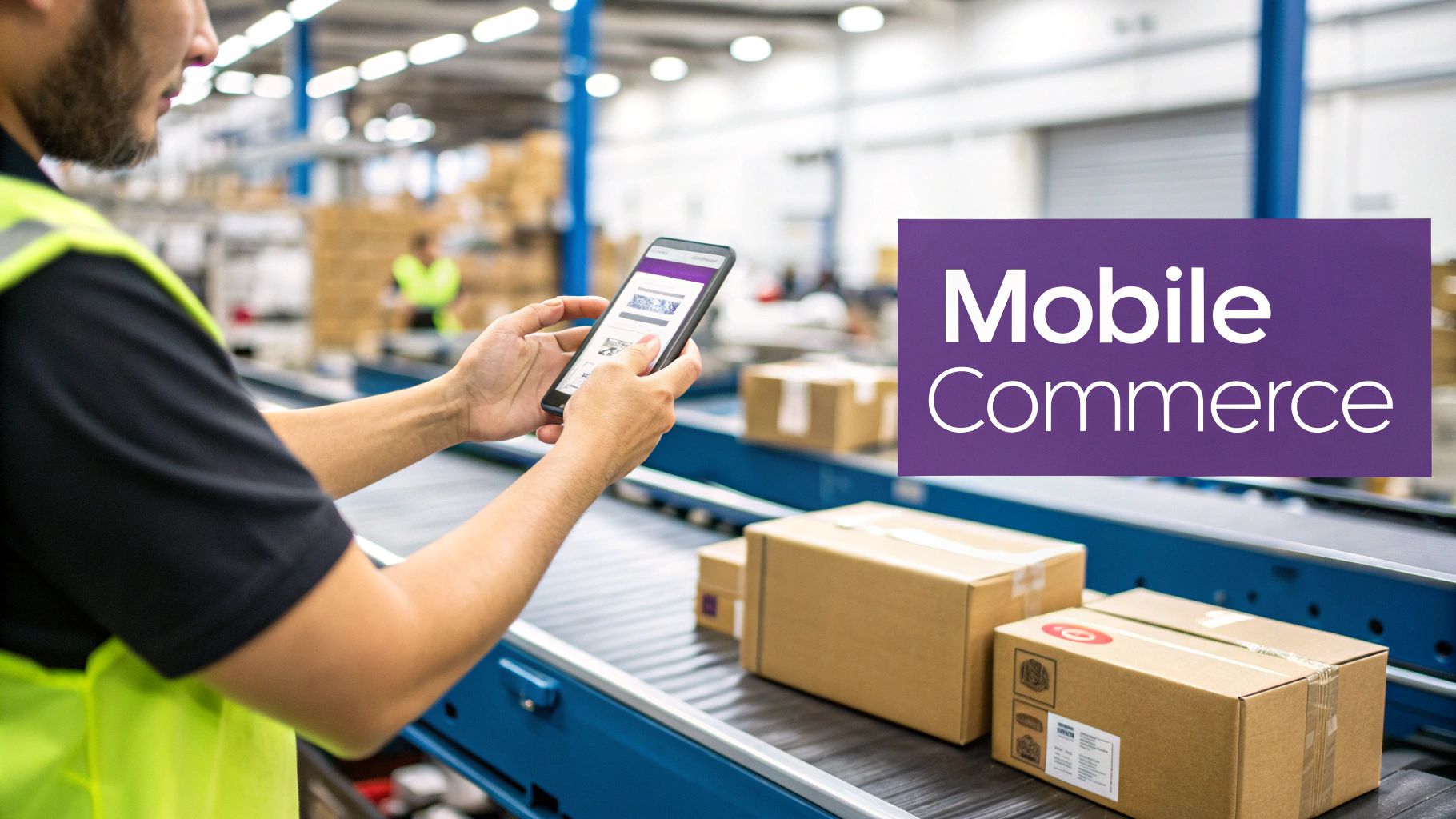
Mobile Commerce and Shipping Restrictions: Ensuring Compliance on All Devices
Learn how to navigate mobile commerce and shipping restrictions to stay compliant across all devices. Optimize your shipping processes and avoid costly errors today!
Cody Y.
Updated on Oct 7, 2025
Ensuring compliance in the world of mobile commerce isn't just a background task—it requires a device-agnostic strategy that validates every single order before the payment goes through. This proactive approach stops costly mistakes in their tracks by building real-time address checks and dynamic shipping rules right into the mobile checkout process, protecting your business from a world of legal and financial headaches.
The Hidden Compliance Risks in Your Mobile Store
The massive shift to mobile shopping has created a hidden challenge for online stores. While you're trying to navigate a complex maze of shipping regulations, your customers are doing it all on a tiny screen. They love the convenience of one-tap checkouts, but behind the scenes, businesses are often unknowingly exposed to huge legal and financial risks. This guide is all about tackling that core problem: how to maintain shipping compliance in a mobile-first world.

Think of your mobile store as a high-speed, global shipping hub. Every package has to clear customs instantly and with perfect accuracy. When that system fails, the consequences can be brutal, ranging from returned shipments and steep financial penalties to legal action and a permanently damaged brand reputation.
The Soaring Stakes of M-Commerce
The sheer scale of mobile commerce makes it painfully clear why getting compliance right is so urgent. By 2023, mobile e-commerce sales hit a staggering $1.7 trillion globally, and that number is expected to climb to around $2.5 trillion by 2025.
As more and more of your revenue flows through mobile devices, the potential losses from non-compliance grow right alongside it. A solid strategy isn't just a good idea; it's essential for survival.
This explosive growth shines a spotlight on several key risks that merchants often don't see until it’s too late:
- Regulatory Fines: Shipping a restricted item to a prohibited location can trigger substantial fines from federal, state, and even local authorities.
- Carrier Penalties: Your logistics partners aren't forgiving. They might impose their own penalties or even terminate your contract if you repeatedly violate their shipping terms for hazardous or prohibited goods.
- Customer Backlash: Nothing kills a customer relationship faster than a canceled order or a seized package. It’s a direct path to negative reviews and losing that customer for good.
A proactive, device-agnostic compliance system isn't just about covering your legal bases; it's a critical business asset. It protects your revenue, builds customer trust, and creates a scalable foundation for growth in an increasingly mobile world.
Beyond the shipping label, how you handle data on mobile devices presents another layer of risk. For a deeper dive into those legal requirements, understanding mobile app privacy policies is crucial to sidestepping potential legal and reputational damage.
Decoding the Complex World of Shipping Restrictions
Before you can build a compliant system, you have to understand the rules of the road. Shipping restrictions aren't a single, monolithic problem; they're a tangled web of rules that change based on what you sell, where you sell it, and how you send it. Trying to apply a one-size-fits-all policy is like using a single key for a dozen different locks—it’s guaranteed to fail.

To get compliance right on every device, from desktop to mobile, you first need to break these regulations down into three core categories. This approach helps untangle the specific challenges your business will face, making the path to a solution much clearer.
Location-Based Restrictions
The most straightforward type of restriction is geographic. Simply put, certain areas have explicit rules about what can and cannot be sent to them. Ignoring these regulations is a fast track to seized packages, costly returns, and frustrated customers.
These rules can be surprisingly specific and vary wildly:
- Country and State Laws: A business selling wine online can ship to customers in Virginia but is legally barred from shipping to Utah due to state laws. International sales add another massive layer of complexity, with each country maintaining its own list of prohibited items.
- Local Ordinances: Some cities or counties have unique restrictions all their own. A local ordinance, for instance, might ban the shipment of certain agricultural products to prevent the spread of invasive pests.
- Address Types: Many carriers simply can’t deliver to P.O. Boxes. Others have specific limitations for shipping to military addresses (APO/FPO/DPO).
Product-Based Restrictions
This category zeroes in on the nature of the items you actually sell. Here, the product itself—not the destination—dictates the shipping rules. These are almost always tied to safety, legal, and health regulations.
Think about a product’s journey from your warehouse to the customer’s door. If it poses a risk at any point in that trip, you can bet special rules will apply.
For example, a bottle of perfume containing alcohol is classified as a flammable liquid. It can't be shipped via air mail with many carriers and requires specific ground shipping methods and hazard labels to move legally.
Other common examples include:
- Perishable Goods: Items like gourmet cheese or fresh flowers require expedited, temperature-controlled shipping to prevent them from spoiling in transit.
- Age-Restricted Products: Selling tobacco or alcohol online requires age verification at the point of delivery, a service not all carriers even offer.
- Regulated Items: Products like firearms, certain supplements, or CBD are governed by strict federal and state regulations that dictate who can buy them and where they can be shipped.
Carrier-Specific Regulations
Finally, each shipping carrier—FedEx, UPS, USPS, DHL—has its own set of internal rules and limitations. These policies are separate from government laws but are just as critical for a successful delivery. Violate them, and you could face rejected shipments or even get your account suspended.
Common carrier-specific rules include things like:
- Weight and Size Limits: A large piece of furniture may exceed one carrier’s maximum weight limit, forcing you to use a different, often more expensive, service.
- Packaging Requirements: Shipping lithium batteries requires special, reinforced packaging designed to prevent fire hazards during transit.
- Service Area Limitations: Some budget carriers might not offer delivery to remote or rural zip codes, requiring you to offer an alternative shipping method at checkout.
Why Mobile Shopping Amplifies Compliance Headaches
The very things that make mobile shopping so great—speed, simplicity, and one-tap convenience—are the exact same things that create massive compliance headaches. A mobile checkout is deliberately streamlined to get a customer from "I want that" to "order confirmed" as fast as possible. But in the race to reduce friction, crucial shipping restriction checks often get left in the dust.
Think of it like an express train versus a local one. A desktop checkout is like the local train, stopping at every station to carefully check tickets and destinations. A mobile checkout is the express, built to blast past smaller stops and get to the final destination faster. While it's incredibly efficient, it might also blow right past an important signal—like a compliance check that's supposed to stop a restricted item from shipping to a prohibited city.
The Mobile Checkout Blind Spots
The mobile environment brings a unique set of challenges to the table that you just don't see as often on a desktop. These small, seemingly harmless differences can snowball into major compliance failures. The pressure to keep forms short and minimize clicks often means that critical validation steps get sacrificed for the sake of a smoother user experience.
This infographic breaks down just how different shipping regulations are across major global regions, hammering home the complexity involved.

The data makes one thing crystal clear: a one-size-fits-all shipping policy is a recipe for disaster. Basic things like package weight limits and the number of restricted goods vary so much from one region to another that your system has to be smart enough to adapt on the fly.
The heart of the problem is that many mobile checkout flows are optimized for conversion at the expense of compliance. They prioritize a frictionless sale over a legally sound one, leaving your business exposed to returned shipments, fines, and angry customers.
Several factors really crank up the risk on mobile devices:
- Simplified Address Forms: To make typing on a tiny screen less painful, mobile forms often skip fields or use aggressive auto-fill. This can easily introduce errors or hide an address's true location (like a specific county or town with its own unique rules).
- Impulse Buys: The ease of one-click buying on a phone is designed to encourage impulse purchases. A customer probably isn't going to pause and read the fine print about shipping limitations before tapping that "Buy Now" button on a restricted product.
- Distracted Shopping: Let's be honest, people are usually doing ten other things while shopping on their phones. They are far more likely to ignore or dismiss warning messages that would be much more obvious on a big desktop screen.
These weak spots aren't just theoretical—they lead to real-world mistakes where you end up selling prohibited items to customers in restricted zones. The only real solution is a system that can enforce your rules without making the mobile experience a clunky nightmare. For a deep dive into how to set this up, you can learn more about how to block non-compliant orders before checkout in WooCommerce in our dedicated guide.
Mobile vs Desktop Compliance Vulnerability Hotspots
This table really puts the platform differences into perspective, showing where things typically go wrong on mobile versus a traditional desktop setup.
| Vulnerability Area | Typical Desktop Experience | Common Mobile Challenge |
|---|---|---|
| Address Entry | Full keyboard and large fields encourage accurate, detailed input. | Small screens, auto-correct, and simplified forms lead to typos and incomplete addresses. |
| Restriction Notices | More screen space allows for prominent display of shipping warnings. | Banners and pop-ups are often dismissed quickly to reduce screen clutter. |
| Checkout Flow | Multi-step process provides more opportunities for validation checks. | Single-page or express checkouts may bypass critical rule-based verifications. |
| User Focus | Shoppers are generally more engaged and attentive to details. | Users are often distracted, leading them to overlook important shipping information. |
As you can see, the streamlined nature of mobile commerce, while great for sales, opens up specific gaps that compliance tools need to be designed to close.
Building a Bulletproof Cross-Device Compliance Strategy
Knowing the risks is one thing; building a system to stop them is another. A reactive strategy that only cleans up messes after they happen isn't just inefficient—it's unsustainable. The goal is to build a proactive, bulletproof compliance strategy that stops bad orders before they’re ever placed, no matter what device the customer is using.

Think of it like a digital customs agent working silently behind the scenes. It inspects every cart and every shipping address in real time, guaranteeing flawless compliance on mobile, desktop, and every device in between. This isn't about adding friction; it's about engineering a smarter, safer checkout from the ground up.
Start with Real-Time Address Validation
The foundation of any good compliance system is clean, accurate data. Manual address entry, especially on a tiny mobile keyboard, is a recipe for typos and missing information that leads straight to costly shipping errors. The single best way to fix this is by integrating a real-time address validation API.
As a customer types, the API instantly checks their address against an official postal database. This simple step does a few critical things:
- Corrects Errors: It automatically fixes misspelled street names and cities.
- Standardizes Formatting: The address is formatted exactly as the local postal service requires.
- Verifies Deliverability: It confirms the address is a real, mailable location, slashing your risk of returned packages.
This automated check ensures every shipping label is based on verified data, which is non-negotiable for the next stages of compliance.
Design a Transparent Checkout Flow
Nothing kills a sale faster than a customer hitting the "Pay Now" button only to be told their order can't be shipped. It’s a frustrating experience that leads directly to abandoned carts. To avoid this, your compliance rules need to be transparent and woven directly into the shopping experience, not bolted on at the very end.
This means your system has to show shipping restrictions early and clearly. If a customer in California adds a restricted item to their cart, a message should pop up right away on the product page or in the cart summary. Don't make them enter their credit card details just to deliver bad news.
A well-designed compliance system prevents surprises. It informs customers about potential shipping issues upfront, turning a potential point of friction into an opportunity to build trust through honesty and transparency.
Implement Dynamic Shipping Rules
The final—and most powerful—piece of the puzzle is a dynamic, rule-based engine that adapts on the fly. This system connects the customer’s location, the specific items in their cart, and your available shipping options to make sure only valid choices are ever presented.
These aren't static, one-size-fits-all rules. They are intelligent, flexible conditions that you define based on your unique needs. For example:
- If a cart contains a "hazmat" product and the destination is Alaska, then hide all air shipping options.
- If the shipping address is a P.O. Box, then only show USPS shipping methods.
- If an order contains alcohol and the destination is outside approved zip codes, then block the checkout completely.
This automated enforcement is the key to ensuring compliance with mobile commerce and shipping restrictions across every device, creating a seamless and error-free process every single time.
Automating Your Shipping Rules for Flawless Execution
Trying to have your fulfillment team manually check every single order against a spreadsheet of shipping rules is just asking for trouble. It's a system guaranteed to fail, especially when you're swamped during the holidays. Human error is inevitable. An automated, rule-based system is the only way to keep up—it acts as a 24/7 compliance officer for your store, on every device.
This shifts your store from being reactive—where you're cleaning up costly mistakes after they happen—to proactive. Instead of dealing with the headache of a restricted item getting shipped to a prohibited state, the system simply stops the invalid order from ever being placed.
The Real-World Benefits of Automation
Automating your shipping logic isn't just about catching errors. It's a smart move that directly improves your bottom line and makes your entire operation run smoother. The benefits show up almost immediately, hitting your revenue, customer happiness, and your team's sanity.
Here’s what you gain:
- Prevent Costly Returns: By blocking orders that aren't compliant before payment, you completely sidestep the costs of return shipping, carrier fines, and lost products.
- Reduce Cart Abandonment: Nothing kills a sale faster than a surprise restriction at the final checkout step. When customers see accurate, valid shipping options from the start, they’re far more likely to complete their purchase.
- Save Hundreds of Manual Hours: Automation liberates your team from the mind-numbing task of cross-checking addresses and cart contents against an ever-changing list of shipping regulations.
Think of automation as a digital gatekeeper for your store. It guarantees that every single order landing in your fulfillment queue is one you can legally and efficiently ship, protecting both your money and your brand's reputation.
Creating Powerful Rules Without Any Code
You don’t need to be a developer to make this happen. Modern tools are built for store owners, not programmers, allowing you to create sophisticated conditional logic without touching a line of code.
An interface like the one in Ship Restrict lets you build specific, powerful rules that match your unique product catalog and the legal landscape you operate in.
This screenshot gives you a glimpse of how granular you can get. You can set up rules based on product tags, where the customer is located, and more, all through a straightforward, user-friendly setup.
This power means you can create precise restrictions that run quietly in the background, 24/7. Even if your business is on a different platform, understanding the core ideas behind automated shipping compliance for Woo Commerce stores provides a valuable blueprint that applies anywhere. The goal is always the same: let the software do the heavy lifting.
Imagine how easy it would be to create rules like these:
- Block all air shipping methods for carts containing flammable liquids.
- Restrict the sale of alcoholic beverages to a specific list of approved zip codes.
- Only show ground shipping options for oversized items.
You set these conditions up once, and you get flawless execution on mobile commerce and shipping restrictions from that point forward. It lets your team get back to focusing on growth instead of putting out fires.
Creating a Frictionless and Compliant Mobile Checkout
Strong compliance should never come at the expense of a great user experience. While automated rules are fantastic for preventing costly errors, how you communicate those restrictions to customers on their phones is what really counts. The goal is to turn a potential roadblock into an opportunity to build trust, keeping your checkout flow smooth and intuitive.
A confusing error code right at the payment step is a guaranteed way to lose a sale. You've got to focus on clear, helpful messaging that shows up early in the process. When a customer adds a restricted item to their cart, a simple, non-intrusive notification should explain the issue in plain English.
Bad message: "Error 501: Shipping validation failed."
Good message: "Sorry, this item isn't available for shipping to your state."
This kind of transparency respects the customer's time and stops frustration before it even starts.
Turning Restrictions into Opportunities
Beyond just blocking a sale, a smart mobile checkout can offer helpful alternatives. If a product is restricted, don’t just show a dead end. Instead, you can guide the user toward a solution that keeps them engaged and ready to buy.
Consider these helpful actions:
- Suggest an alternative product: If a specific vape liquid can’t ship to their location, recommend a similar, non-restricted item they can buy.
- Offer in-store pickup: Let the customer know they can still purchase the item if they can grab it locally.
- Provide more information: Link to a clear FAQ page that explains why the restriction exists. This reinforces your commitment to doing things by the book.
This kind of proactive communication is just plain good customer service. To make sure your compliant mobile checkout doesn't scare customers away, it's also critical to minimize unexpected costs, which is a primary driver of abandoned carts. For some practical approaches, you can explore effective strategies to reduce cart abandonment.
On a more technical level, learning how to hide shipping methods based on cart contents in Woo Commerce can dramatically streamline the user experience by only showing options that are actually valid. By integrating clear messaging with helpful alternatives, you can nail your mobile commerce and shipping restrictions compliance while maintaining a frictionless, user-friendly checkout on any device.
Common Questions About Shipping Compliance
When you're trying to get your shipping rules dialed in, especially for mobile shoppers, a lot of questions pop up. Let's walk through some of the most common ones we hear from store owners trying to build a system that's both compliant and efficient.
How Do I Handle Rules for International Mobile Shoppers?
Selling internationally means you absolutely need a system that can automatically check country-specific regulations, validate address formats, and clearly calculate duties and taxes on the fly. Trying to do this manually is a recipe for disaster—it's just too complex.
The key is to always show the final landed cost before the customer pays. This simple step prevents the vast majority of chargebacks and keeps your international customers happy.
If there's one major compliance mistake stores make on mobile, it's using a one-size-fits-all shipping policy. Too often, merchants fail to set up dynamic rules that adapt to where the customer is and what's actually in their cart. This leads to taking orders you can't fulfill, which means cancellations, lost money, and a serious hit to your brand's reputation.
Can I Set Up Advanced Shipping Restrictions Without Coding?
You sure can. Modern platforms like WooCommerce have apps designed for exactly this. A tool like Ship Restrict, for instance, gives you a simple interface to build out all the complex shipping rules you need.
You can restrict or allow shipping methods based on all sorts of conditions, no developer needed:
- Product tags or categories
- Customer location (down to the state, city, or zip code)
- Cart value or total weight
This is how you build a solid compliance framework for mobile commerce and shipping restrictions without getting bogged down in technical details.
Ready to automate your shipping compliance and stop costly mistakes before they happen? Ship Restrict gives you the power to create precise, automated shipping rules for WooCommerce without any coding. Learn more and get started at https://shiprestrict.com.

Cody Yurk
Founder and Lead Developer of ShipRestrict, helping e-commerce businesses navigate complex shipping regulations for regulated products. Ecommerce store owner turned developer.